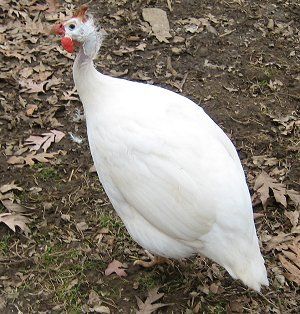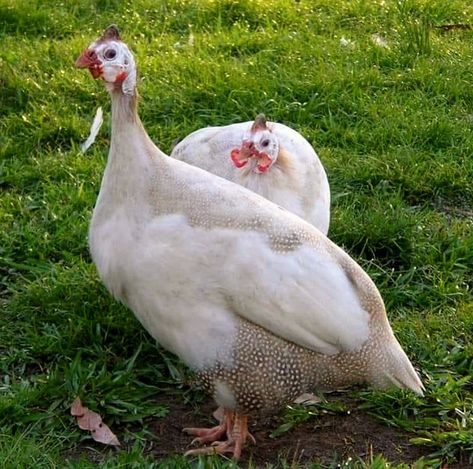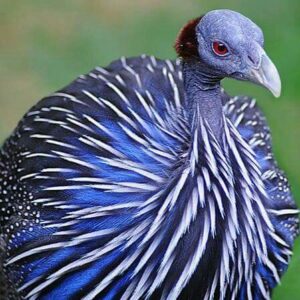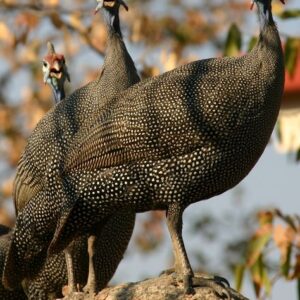The White Guinea Fowl is a unique and visually striking variety of guinea fowl, known for its pure white plumage that sets it apart from other more commonly speckled varieties like the Pearl Guinea Fowl. This domesticated bird is prized for its ornamental beauty, utility in pest control, and its hardy nature, making it a popular choice for both farms and backyards. Its adaptability and practical benefits have made it a favorite among poultry enthusiasts and small-scale farmers alike.
Physical Characteristics
White Guinea Fowl are medium-sized birds with rounded bodies and a sleek appearance. Their bright white feathers lack the characteristic spots of other guinea fowl varieties, giving them a clean and elegant look. Their heads and upper necks are bare, featuring brightly colored blue and red patches of skin, and a small bony casque, which is typical of guinea fowl. They have sturdy legs and a short, curved beak, well-suited for ground foraging.
Behavior and Social Traits
Like all guinea fowl, the White Guinea Fowl is highly active and social, thriving in small to large flocks. These birds are primarily ground dwellers, spending most of their time foraging for insects, seeds, grains, and other food items. They are known for their loud, repetitive calls, which serve to keep the flock together and alert them to potential predators or disturbances. Their vocal nature also makes them excellent “watchdogs,” as they are quick to raise alarms when something seems amiss.
Habitat and Care
White Guinea Fowl are highly adaptable and can thrive in various environments, from open fields and grasslands to farmyards and backyards. They prefer free-range systems where they can forage naturally but will also benefit from supplemental feed, especially in confined settings. At night, these birds typically roost in trees or coops for safety. They require minimal care, aside from access to clean water, shelter, and protection from predators.
Reproduction and Breeding
White Guinea Fowl are seasonal layers, producing clutches of 12–15 eggs in hidden ground nests. Their eggs are small, hard-shelled, and highly nutritious. The incubation period lasts about 26–28 days, after which the chicks, known as keets, hatch. Keets are precocial, meaning they can move and feed independently shortly after hatching but require protection and warmth in their early days.
Benefits and Uses
The White Guinea Fowl offers both aesthetic and practical value. Its striking appearance makes it a popular ornamental bird, adding beauty to any property. Additionally, these birds are excellent at controlling pests like ticks, grasshoppers, and other small insects, making them beneficial for farms and gardens. They also produce lean, flavorful meat and nutritious eggs, though they are typically raised more for their pest control and ornamental qualities than for production.
Conservation and Popularity
While not a wild species, the domesticated White Guinea Fowl is widely raised and well-established. Their popularity continues to grow due to their combination of beauty, utility, and low maintenance requirements. They are particularly valued in areas where natural pest control and hardy, low-input poultry are needed.
Conclusion
The White Guinea Fowl is a versatile and visually stunning bird that brings both functionality and charm to farms, backyards, and estates. Its adaptability, combined with its ability to manage pests and add ornamental value, makes it an excellent choice for poultry enthusiasts and small-scale farmers alike. Whether raised for practical benefits or simply as an attractive addition to a property, White Guinea Fowl are a unique and rewarding species to keep.









Reviews
There are no reviews yet.